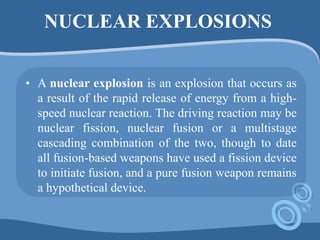
Nuclear Explosions and Disasters Explained
- 1. NUCLEAR EXPLOSIONS • A nuclear explosion is an explosion that occurs as a result of the rapid release of energy from a high- speed nuclear reaction. The driving reaction may be nuclear fission, nuclear fusion or a multistage cascading combination of the two, though to date all fusion-based weapons have used a fission device to initiate fusion, and a pure fusion weapon remains a hypothetical device.
- 2. Contd… • Atmospheric nuclear explosions are associated with mushroom clouds, although mushroom clouds can occur with large chemical explosions. It is possible to have an air-burst nuclear explosion without these clouds. Nuclear explosions produce radiation and radioactive debris.
- 3. Contd… • Nuclear disasters generally occur in nuclear reactors which are used to generate electric power. Accidents can occur during transportation of nuclear waste or during temporary storage of spent radioactive fuel at nuclear power plants. • Strontium-90, Uranium-235, Cesium-137 are some examples of radio active materials
- 4. CAUSES OF NUCLEAR HAZARDS • Nuclear disasters occur as a result of result of release of massive amount of radiation and radio active material into the environment. They have the greatest damage potential, over a wide geographical area, often leading to mass destruction of human civilization.
- 5. CAUSES OF NUCLEAR HAZARDS • Nuclear disasters and accidents usually occur in nuclear reactors that are used to generate electric power. Some of the major causes • Release of massive amounts of radiation and radioactive material • Improper transportation of nuclear waste has potential risk of pollution and environmental contamination. • Improper storage of spent radioactive fuel at nuclear power plants.
- 6. CAUSES OF NUCLEAR HAZARDS • Non-standard operations, mismanagement of nuclear reactors • Poor instrumentation • Lack of well-trained staff • Unreliable Instruments • Errors in operation procedures • Spills & Leaks from nuclear industry, medical radiology and defense activities
- 7. CHERNOBYL DISASTER • The disaster at the Chernobyl nuclear power plant in north-central Ukraine on April 26, 1986 is considered as one of the greatest nuclear accidents of all time. On the fateful day, one of the reactors of the nuclear power plant exploded and released thirty to forty times the radioactivity of the atomic bombs dropped on Hiroshima and Nagasaki.
- 8. Contd… • About 30 people were killed immediately, including 28 from radiation exposure, 209 cases were treated for acute radiation poisoning. Large areas of Ukraine, Russia and beyond were contaminated with radioactive material in varying degrees. A second explosion caused burring of 1200 tonnes of graphite for nine days and releasing of radioactive material into the environment. About 5000 tonnes of boron, dolomite, sand, clay and lead were dropped on the flames bursting out of the graphite moderator in an effort to put off the blaze and control the release of radioactive particles.
- 9. Impacts of the nuclear disaster • Nearly, 45% of children have experience with thyroid exposure to radiation. • In order to protect the children from radiation exposure, the top soil from the school yards have been removed, the walls of the school building have been cleaned, and the gutters have been cleared of the mud as well.
- 10. Impacts of the nuclear disaster • Reports from WHO indicate that the Agricultural Products, milk and seafood have been contaminated with radioactive material. • The nation may be struggled to find effective methods to monitor health, protect its food supply from contamination and complicated poster disaster clean up.